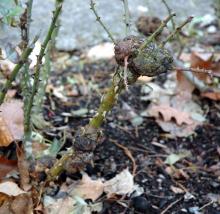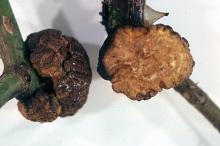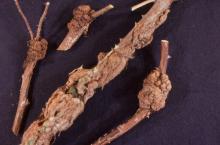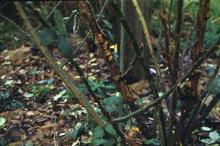See:
Cherry (Prunus spp.) - Crown Gall
Cause The bacterium Rhizobium radiobacter (formerly Agrobacterium tumefaciens) enters plants through wounds, either natural or caused by pruning, grafting, mechanical injury from cultivation, heaving of frozen soils, chewing insects, or the emergence of lateral roots. Systemic populations that initiate disease are as important in rose as they are in grape and walnut. After the bacterium enters a wound, a small piece of its DNA is transferred into the plant's DNA. The foreign DNA transforms normal plant cells in the wounded area into tumor cells. Once transformed, tumor cells proliferate automatically. The result is a gall: a disorganized mass of hyperplastic and hypertrophic tissue.
Pruning tools that cut through galls can become contaminated with the bacteria and spread them to cut surfaces of subsequently pruned plants. Galls breaking down in soil release bacteria, which can be transported by moving soil or water. In the absence of plant roots, bacterial populations gradually decrease; however, the pathogen may survive in soil for as long as 3 years. Many plants in 90 families are susceptible but woody perennials such as stone and pome fruit, caneberries (such as blackberry and raspberry), euonymus, Photinia, poplar, rose, walnut, and willow are typically infected.
Symptoms Galls are often at or just below the soil surface in the basal or root crown region. They may frequently be on roots, less frequently on aerial plant parts. Galls are usually rounded with a rough, irregular surface. They first appear as small protuberances on the plant surface. Young, actively developing galls are light green or nearly white, and the tissue is soft. As they age, galls become dark and woody. Outer portions can slough off with age. Sometimes galls have a rather smooth surface, which makes it difficult to distinguish between gall and callus growth, especially if the gall is at the plant base or at the graft or bud union. Plants can be stunted and have reduced vigor, poor foliage, and fewer blossoms. A single gall at the plant's base may be more detrimental than several galls on canes and roots. Symptoms may not develop for over a year if infection occurs when temperatures are below 59°F.
Cultural control
- Use only pathogen-free nursery stock. Inspect new plants; do not plant any rose that has galls.
- Avoid wounding plants, especially at planting. If root pruning at planting, soak in biocontrol agent listed below.
- Use plants with resistant rootstocks. Rootstocks differ widely in susceptibility.
- Prune off any galls on aerial parts of the plant.
- Disinfect pruning shears frequently. Clean shears and long soak times improve the disinfectant's efficacy. Disinfestants include bleach, peroxides, and quaternary ammonium products.
- Remove and destroy any affected plants.
- Preplant soil solarization has been helpful in reducing populations of certain soilborne pathogens and weeds in western Oregon. Place clear plastic (preferably anti-condensation film) directly on smooth, rototilled ground, which has been irrigated to field capacity and then allowed to drain for 1-2 days. Bury the edges of the plastic to trap the heat. Solarize for 4-6 weeks (or longer) during the hottest part of the summer, beginning in early- to mid-July. The technique may help after removing diseased plants from a bed in which roses will be planted again.
Chemical control
Products available in home packaging:
- Ferti-lome Fire Blight Spray (streptomycin) at 2 Tbsp/2.5 gal water. Soak root system and cut surfaces for 15 min. in this solution. This works better as a wound protectant than as a cure. Cutting away galls, as label directs, may help, but all galled tissue must be removed. Getting a new, pathogen-free plant will work better. Foliar sprays, as label directs, are not recommended. Group 25 fungicide. H O
Products available for commercial use:
- Agri-Mycin 50 at 1.3 to 5.3 oz/100 gal water depending on use. Tolerant strains of bacteria easily develop with repeated use of this product. Alternate with other bactericides to prevent or delay buildup of tolerant strains. Group 25 fungicide. 12-hr reentry.
- Gallex (ready to use) painted on very young galls to reduce further development. Galls may return the following year or, if treated late, may continue to develop. Tissue surrounding the gall may be injured, especially on younger plants. Prepare the surface by removing soil from around the galled area, and allow the area to dry before application. Not registered in Idaho. 24-hr reentry.
- FireWall at 0.34 to 1.36 oz/25 gal water depending on use. Label directs to dig out plant, remove galled tissue and soak in solution for 15 min before replanting. Unknown efficacy. Group 25 fungicide. 12-hr reentry.
Biological control Agrobacterium radiobacter strain 84 has been used successfully with roses in Australia, New Zealand, and Spain but has not been effective in limited trials in the United States. Strain K 84 is preventive only. Latent infections (symptomless) and existing galls are not controlled. A suspension of strain 84 may be used as a soak or spray. Thoroughly cover grafting wood, roots, and crown. Spray to runoff. To be effective, it must be applied a few hours after wounding.
- Galltrol-A (Agrobacterium radiobacter K84). Not registered in Idaho. 12-hr reentry. O
- NOGALL at 8.8 oz/2.5 gal unchlorinated water per 2,500 nonbearing plants. Apply within 2 hours of lifting and/or damaging plants. Do not use with any pesticides or fertilizers. 4-hr reentry. O
Reference Horst, R.K. and Cloyd, R.A. 2007. Compendium of Rose Diseases and Pests. Second Edition. APS Press. St. Paul, MN.





